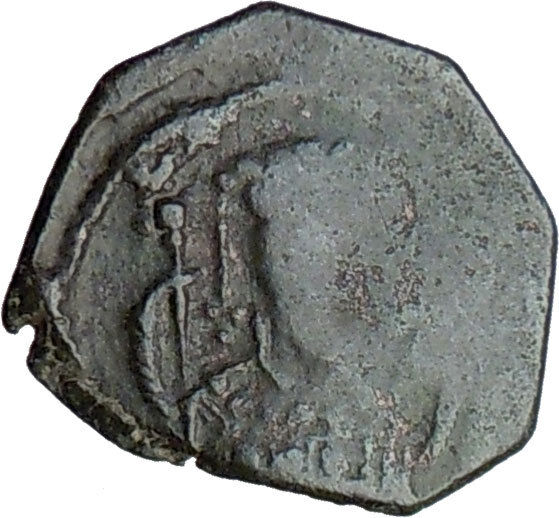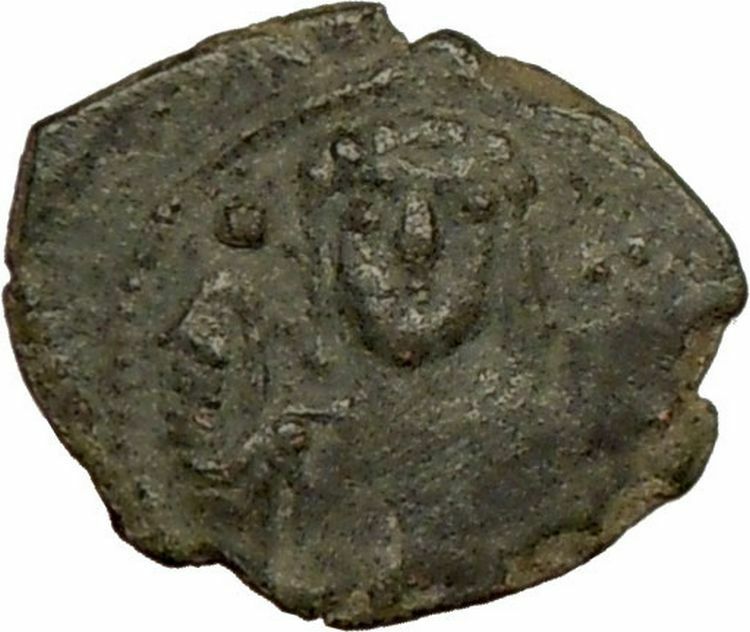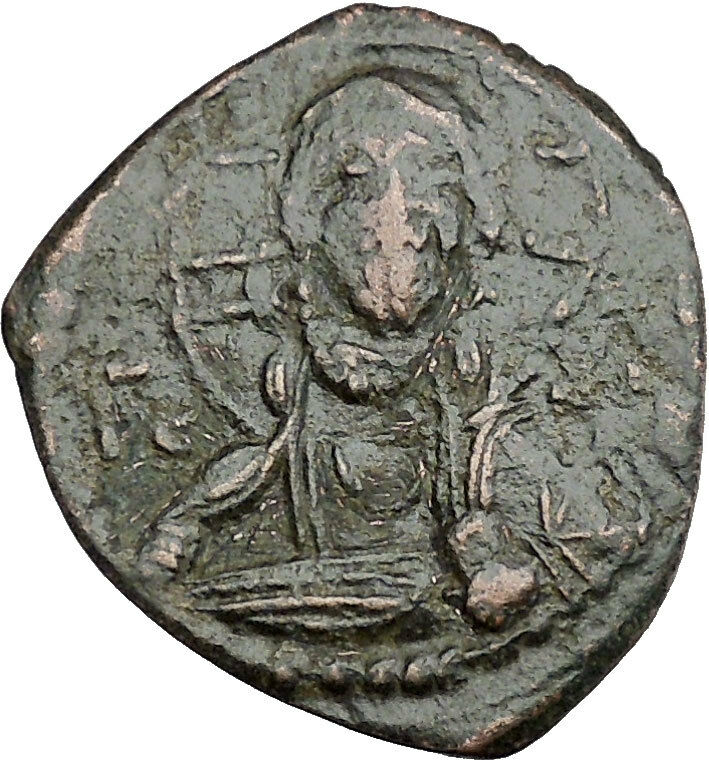|
Byzantine Empire
Leo III the Isaurian – Byzantine Emperor: March 25, 717 – June 18, 741 A.D.
with Constantine V, Copronymus
Gold Solidus 17mm (3.98 grams) Syracuse mint, struck 737-741 A.D.
Reference: Sear 1524.
Certification: NGC Ancients Ch AU Strike: 3/5 Surface: 4/5 6057013-019
CNO LЄON P A MЧL, crowned facing bust of Leo III, wearing chlamys pinned at right shoulder, globus cruciger in right hand, akakia in left.
C N CONS-tANtINЧ, crowned facing bust of Constantine V, beardless, wearing chlamys pinned at right shoulder, globus cruciger in right hand, akakia in left.
You are bidding on the exact item pictured, provided with a Certificate of Authenticity and Lifetime Guarantee of Authenticity.
Leo III the Isaurian also known as the Syrian (Greek: Λέων Γ΄ ὁ Ἴσαυρος, Leōn III ho Isauros), (c. 685 – 18 June 741) was Byzantine Emperor from 717 until his death in 741. He put an end to a period of instability, successfully defended the Empire against the invading Umayyads, and forbade the veneration of icons.
Leo, whose original name was Konon, was born in Germanikeia in the Syrian province of Commagene (modern Kahramanmaraş in Turkey). Some, including the Byzantine chronicler Theophanes, have claimed that Konon’s family had been resettled in Thrace, where he entered the service of Emperor Justinian II, when the latter was advancing on Constantinople with an army of 100,000 horsemen provided by Tervel of Bulgaria in 705.
After the victory of Justinian II, Konon was dispatched on a diplomatic mission to Alania and Lazica to organize an alliance against the Umayyad Caliphate under Al-Walid I. Konon was appointed commander (stratēgos) of the Anatolic theme by Emperor Anastasius II. On his deposition, Konon joined with his colleague Artabasdus, the stratēgos of the Armeniac theme, in conspiring to overthrow the new Emperor Theodosius III. Artabasdus was betrothed to Anna, daughter of Leo as part of the agreement.
Siege of Constantinople
Leo entered Constantinople on 25 March 717 and forced the abdication of Theodosios III, becoming emperor as Leo III. The new Emperor was immediately forced to attend to the Second Arab siege of Constantinople, which commenced in August of the same year. The Arabs were Umayyad forces sent by Caliph Sulayman ibn Abd al-Malik and serving under his brother Maslama ibn Abd al-Malik. They had taken advantage of the civil discord in the Byzantine Empire to bring a force of 80,000 to 150,000 men and a massive fleet to the Bosphorus.
Careful preparations, begun three years earlier under Anastasius II, and the stubborn resistance put up by Leo wore out the invaders. An important factor in the victory of the Byzantines was their use of Greek fire. The Arab forces also fell victim to Bulgarian reinforcements arriving to aid the Byzantines. Leo was allied with the Bulgarians but the chronicler Theophanes the Confessor was uncertain if they were still serving under Tervel or his eventual successor Kormesiy of Bulgaria.
Unable to continue the siege in the face of the Bulgarian onslaught, the impenetrability of Constantinople’s walls, and their own exhausted provisions, the Arabs were forced to abandon the siege in August, 718. Sulayman himself had died the previous year and his successor Umar II would not attempt another siege. The siege had lasted 12 months.
Having thus preserved the Empire from extinction, Leo proceeded to consolidate its administration, which in the previous years of anarchy had become completely disorganized. In 718 he suppressed a rebellion in Sicily and in 719 did the same on behalf of the deposed Emperor Anastasios II.
Leo secured the Empire’s frontiers by inviting Slavic settlers into the depopulated districts and by restoring the army to efficiency; when the Umayyad Caliphate renewed their invasions in 726 and 739, as part of the campaigns of Hisham ibn Abd al-Malik, the Arab forces were decisively beaten, particularly at Akroinon in 740. His military efforts were supplemented by his alliances with the Khazars and the Georgians.
Leo undertook a set of civil reforms including the abolition of the system of prepaying taxes which had weighed heavily upon the wealthier proprietors, the elevation of the serfs into a class of free tenants and the remodelling of family, maritime law and criminal law, notably substituting mutilation for the death penalty in many cases. The new measures, which were embodied in a new code called the Ecloga (Selection), published in 726, met with some opposition on the part of the nobles and higher clergy. The Emperor also undertook some reorganization of the theme structure by creating new themata in the Aegean region.
Iconoclasm
Leo’s most striking legislative reforms dealt with religious matters, especially iconoclasm (“Icon-breaking,” therefore an iconoclast is an “Icon-breaker”). After an apparently successful attempt to enforce the baptism of all Jews and Montanists in the empire (722), he issued a series of edicts against the worship of images (726-729). This prohibition of a custom which had been in use for centuries seems to have been inspired by a genuine desire to improve public morality, and received the support of the official aristocracy and a section of the clergy. A majority of the theologians and all the monks opposed these measures with uncompromising hostility, and in the western parts of the Empire the people refused to obey the edict.
A revolt which broke out in Greece, mainly on religious grounds, was crushed by the imperial fleet in 727 (cf. Agallianos Kontoskeles). In 730, Patriarch Germanos I of Constantinople resigned rather than subscribe to an iconoclastic decree. Leo had him replaced by Anastasios, who willingly sided with the Emperor on the question of icons. Thus Leo suppressed the overt opposition of the capital.
In the Italian Peninsula, the defiant attitude of Popes Gregory II and Gregory III on behalf of image-veneration led to a fierce quarrel with the Emperor. The former summoned councils in Rome to anathematize and excommunicate the iconoclasts (730, 732); In 740 Leo retaliated by transferring Southern Italy and Illyricum from the papal diocese to that of the Patriarch of Constantinople. The struggle was accompanied by an armed outbreak in the exarchate of Ravenna in 727, which Leo finally endeavoured to subdue by means of a large fleet. But the destruction of the armament by a storm decided the issue against him; his southern Italian subjects successfully defied his religious edicts, and the Exarchate of Ravenna became effectively detached from the Empire.
The emperor died of dropsy in June 741.
Constantine V (718 – September 14, 775) (Greek: Κωνσταντίνος Ε΄, Kōnstantinos V; denigrated by his enemies as Kopronymos or Copronymus, meaning the dung-christened) was Byzantine Emperor from 741 to 775.
Constantine was born in Constantinople, the son and successor of Emperor Leo III and Maria. In August 720 he was associated on the throne by his father, who had him marry Tzitzak, daughter of the Khazar khagan Bihar. His new bride was baptized as Irene (Eirēnē, “peace”) in 732. Constantine V succeeded his father as sole emperor on 18 June 741.
Civil war against Artabasdos
In June 741 or 742, while Constantine was crossing Asia Minor to campaign on the eastern frontier against the Umayyad Caliphate under Hisham ibn Abd al-Malik, he was attacked by the forces of his brother-in-law Artabasdos, husband of his older sister, Anna. Artabasdos was the stratēgos of the Armeniac theme.
Constantine was defeated and sought refuge in Amorion, while Artabasdos advanced on Constantinople and was accepted as Emperor. Constantine received the support of the Anatolic and Thracesian themes; Artabasdos secured the support of the themes of Thrace and Opsikion, in addition to his own Armeniac soldiers.
The rival emperors bided their time making military preparations. Artabasdos marched against Constantine in May 743 but was defeated. Three months later Constantine defeated Artabasdos’ son Niketas and headed for Constantinople. In early November Constantine was admitted into the capital and immediately turned on his opponents, having them blinded or executed.
The usurpation of Artabasdos was connected with restoring the veneration of images, leading Constantine to became perhaps an even more fervent iconoclast than his father. Constantine’s avowed enemies over this extremely emotional issue, the iconodules, applied to him the derogatory epithet Kopronymos (“dung-named”, from kopros, meaning “feces” or “animal dung”, and onoma, “name”). Using this obscene name, they spread the rumour that as an infant he had defecated in his baptismal font, or the imperial purple cloth with which he was swaddled.
Campaign pro iconoclasm
Further information: Byzantine Iconoclasm
Constantine’s position on Iconoclasm was clear:
….He cannot be depicted. For what is depicted in one person, and he who circumscribes that person has plainly circumscribed the divine nature which is incapable of being circumscribed.
In February 754 Constantine convened a synod at Hieria, which was attended entirely by Iconoclast bishops. The council approved of Constantine’s religious policy and secured the election of a new Iconoclast patriarch, but refused to follow in all of Constantine’s views. The council confirmed the status of Mary as Theotokos, or Mother of God, reinforced the use of the terms “saint” and “holy” as meet, and condemned the desecration, burning, or looting of churches in the quest to quench Iconophiles.
The synod was followed by a campaign to remove images from the walls of churches and to purge the court and bureaucracy of Iconodules. Since monasteries tended to be strongholds of Iconophile sentiment, Constantine specifically targeted the monks, pairing them off and forcing them to marry nuns in the Hippodrome and expropriating monastic property for the benefit of the state or the army. The repressions against the monks (culminating in 766) were largely led by the Emperor’s general Michael Lachanodrakon, who threatened resistant monks with blinding and exile. An iconodule abbot, Stephen Neos, was brutally lynched by a mob at the behest of the authorities. As a result many monks fled to Southern Italy and Sicily.
By the end of Constantine’s reign, Iconoclasm had gone as far as to brand relics and prayers to the saints as heretical. Ultimately, iconophiles considered his death a divine punishment. In the 9th century he was disinterred, and his remains were thrown into the sea.
Campaigns against the Arabs and Bulgaria
Constantine was an able general and administrator. He reorganised the themes, the military districts of the Empire, and created new field army divisions called tagmata. This organization was intended to minimize the threat of conspiracies and to enhance the defensive capabilities of the Empire. With this reorganized army he embarked on campaigns on the three major frontiers.
In 746, profiting by the unstable conditions in the Umayyad Caliphate, which was falling apart under Marwan II, Constantine invaded Syria and captured Germanikeia (modern Maraş, his father’s birthplace). He organised the resettlement of part of the local Christian population to Imperial territory in Thrace. In 747 his fleet destroyed the Arab fleet off Cyprus. In 752 he led an invasion into the new Abbasid Caliphate under As-Saffah. Constantine captured Theodosioupolis and Melitene (Malatya) and again resettled some of the population in the Balkans. These campaigns failed to secure any concrete gains (apart from additional population employed to strengthen another frontier), but it is important to note that under Constantine V the Empire had gone on the offensive.
Meanwhile, with Constantine occupied, Lombard king Aistulf captured Ravenna in 755, ending over two centuries of Byzantine rule.
The successes in the east made it possible to pursue an aggressive policy in the Balkans. With the resettlement of Christian populations from the East into Thrace, Constantine V aimed to enhance the prosperity and defence of the area, causing concern to the Empire’s northern neighbour, Bulgaria, and leading the two states to clash in 755. Kormisosh of Bulgaria raided as far as the Anastasian Wall but was defeated in battle by Constantine V, who inaugurated a long series of nine successful campaigns against the Bulgarians in the next year, scoring a victory over Kormisosh’s successor Vinekh at Marcelae.
Three years later, Constantine was defeated in the battle of the Rishki Pass, but the Bulgarians did not exploit their success. In 763, he sailed to Anchialus with 800 ships carrying 9,600 cavalry and some infantry. Constantine’s victories, including that at Anchialus in 763, caused considerable instability in Bulgaria, where six monarchs lost their crowns on account of their failures.
In 775, Constantine was persuaded to reveal to the Bulgarian ruler Telerig the identities of his agents in Bulgaria, and they were promptly eliminated. Constantine thus began preparations for a new campaign against the Bulgarians, during which he died, on September 14, 775.
Constantine’s campaigns were costly; during his reign the Byzantine Empire’s annual revenues were reduced to about 1,800,000 nomismata due to his various wars and the Arab conquests.
By his first wife, Tzitzak (“Irene of Khazaria”), Constantine V had one son:
- Leo IV, who succeeded as emperor.
By his second wife, Maria, Constantine V is not known to have had children.
By his third wife, Eudokia, Constantine V had five sons and a daughter:
- Christopher, Caesar
- Nikephoros, Caesar
- Niketas, Nobelissimos
- Eudokimos, Nobelissimos
- Anthimos, Nobelissimos
- Anthousa
|














